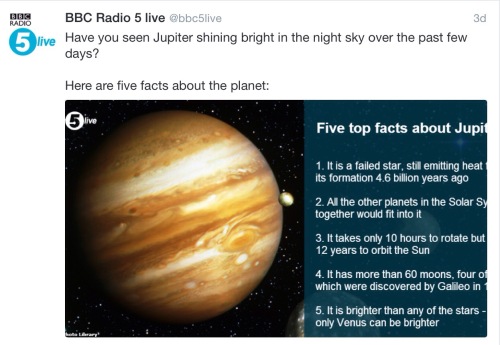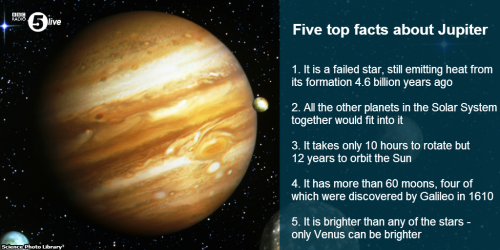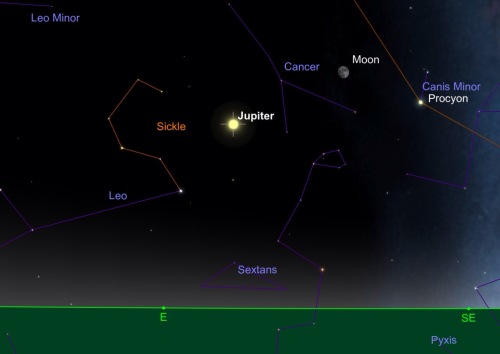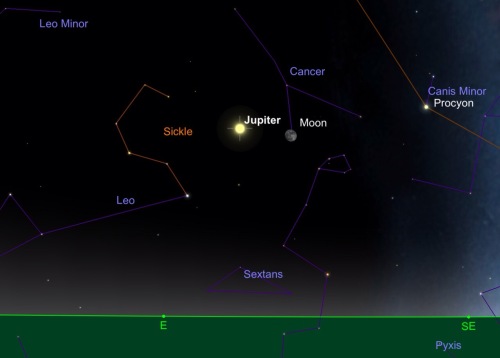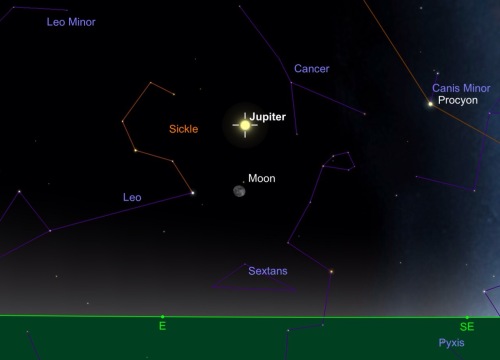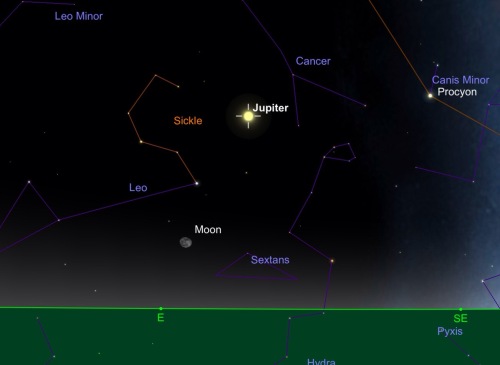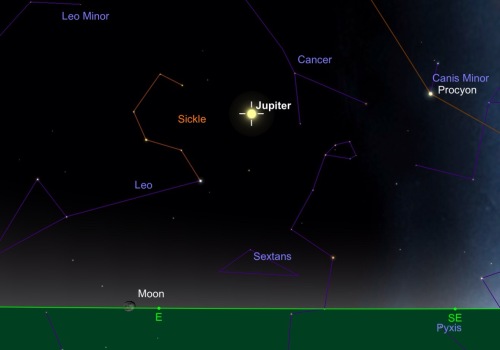On Tuesday morning of last week (the 3rd) I woke up early, which is a habit I am trying to get back into so that I can recommence my running, which I try to do first thing in the morning before work. In a semi-awake state I was listening to BBC Radio 5’s breakfast show co-presenter Rachel Burden and someone else on the show between 6 and 7 (was it George Riley the sports person or someone else??) discussing how they had seen the Moon and Jupiter very bright in the sky on Monday evening.
The following morning during the same 6-7am period, the discussion was resumed with remarks being made about how much Jupiter had moved away from the Moon. I decided to tweet into the show and to Rachel saying that it was the Moon which has moved, not Jupiter. To cut a long story short, I ended up being on the show on the Thursday morning to explain what was moving and why. Here is a link to a recording of my 3-minute stint, where Rachel and Nicky Campbell (Rachel’s co-presenter) interview me.
The evening before my being on the show, one of the show’s researchers had asked me to send in a list of the five most interesting facts about Jupiter. They then put those out as a tweet during my interview. I chose the following five, would you have chosen the same ones?
I will talk about each of these five facts separately in future blogs over the next several weeks. I will also blog in a little more detail about the NASA mission to Europa and the proposed ESA mission Juice; both of which intend to study this fascinating moon in more detail.
Being on the radio it is, of course, impossible to show diagrams about the motion of the Moon and Jupiter; and there really wasn’t enough time to explain it properly. So, I have decided to put together these slides to explain it in a little more detail.
Jupiter and the Moon during the first week of February 2015
Getting software to show you what is in the sky is easy, and although for PCs and Macs you may end up paying several tens of pounds, for tablet devices the software is much cheaper, with many reasonable ones being free. I use “Skysafari”, which is not free but is not too expensive either. It is made by Carina Software, who made the wonderful Voyager Software on Macs that I used for many many years in my classes.
Below is a screen capture using this software of the sky as seen from London at 20:00 on Thursday the 5th of February 2015. As you can see, I have done the screen capture with Jupiter just to the left (East) of the middle of the window (in the software you can use your finger to move around and look in different directions such as north or north-east if you wish). The Moon is at about 7 o’clock from Jupiter in direction, if you imagine a clock face.
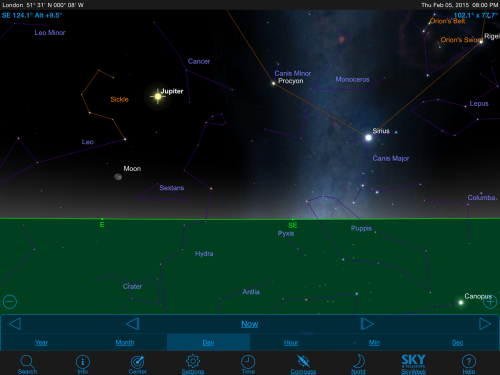
This is a screen capture from an app I use on my iPad called “Skysafari” which can show what is in the sky at any location and at any time and date. There are lots of other similar apps available, but I like this one the most of the ones I’ve tried. This is the screen capture looking south for 20:00 on Thursday the 5th of February 2015 as seen from London.
Below I show a sequence of screen captures of Jupiter and the Moon (I have zoomed in on just enough to show the two) from Monday evening (the 2nd) to Friday evening (the 6th), all at 20:00 to show the motion of the Moon compared to Jupiter’s position.
I think these screen captures make it quite easy to see that Jupiter is staying fixed in the same place relative to the stars during this sequence (which spans 5 nights), and it is the Moon which is moving. Why is this?
The Motion of the Moon in the sky
The reason it is the Moon which appears to move against the background of Jupiter and the stars is because the Moon is orbiting us; whereas Jupiter is orbiting the Sun and the stars are not orbiting the Sun but are, along with the Sun, in fact orbiting the centre of our Milky Way galaxy.
As the Moon takes roughly 30 days to orbit the Earth (see this blog for the more precise figure, and the difference between how long it takes to orbit the Earth – the “sidereal month” – and how long it is between two New Moons – the “synodic months”), then if we divide by 30 we get that the Moon moves
in its orbit about the Earth each day/night. This figure is only approximate (but good enough for our purposes) because (a) a sidereal month is not exactly 30 days and (b) the Moon moves in an ellipse and not a circle about the Earth, and so changes its speed at different points in the orbit, so does not move the same amount each 24 hour period.
As the Moon is in diameter,
corresponds to 24 times the diameter of the Moon. This is quite a lot, and so the motion of the Moon from night to night against the background planets and stars is very easily seen, as the sequence of diagrams above show.
In fact, Jupiter is also moving against the background stars, but it does so much more slowly. Jupiter takes about 12 years to orbit the Sun, and so each year it moves roughly 1/12th of a full circle. Along with the Sun, the Moon and the other planets, Jupiter moves through the zodiacal constellations during its travels, and so moves roughly into a new zodiacal constellation each year. At the moment it is in Cancer, but by this time next year it will be in Leo, the next constellation along the zodiac to the East (to the left of Cancer in the diagram above). You may be able to notice that Jupiter has moved relative to the background stars in a month or two, but certainly by next February, if you remember where it is now, you will see a difference.
Finally, although we refer to the stars as “the fixed stars”, they are not fixed. They, along with our Sun, are orbiting the centre of our Milky Way galaxy. Our Sun will take 250 million years to do this, stars closer to the centre of the Milky Way will take less time and stars further out from the centre will take longer. This leads to the positions of the stars relative to each other changing, but the change is very very slow, taking tens of thousands of years to be noticeable.
